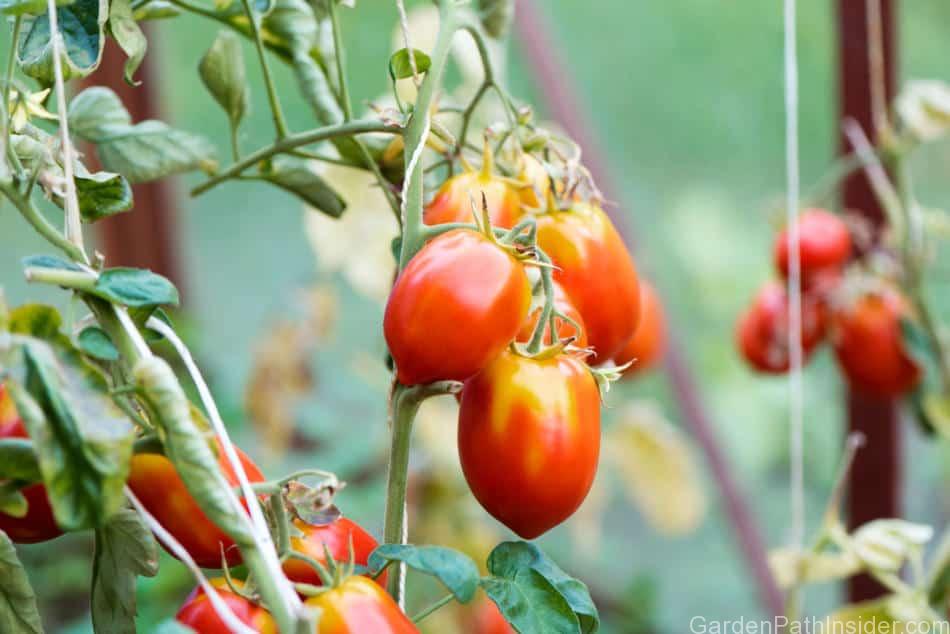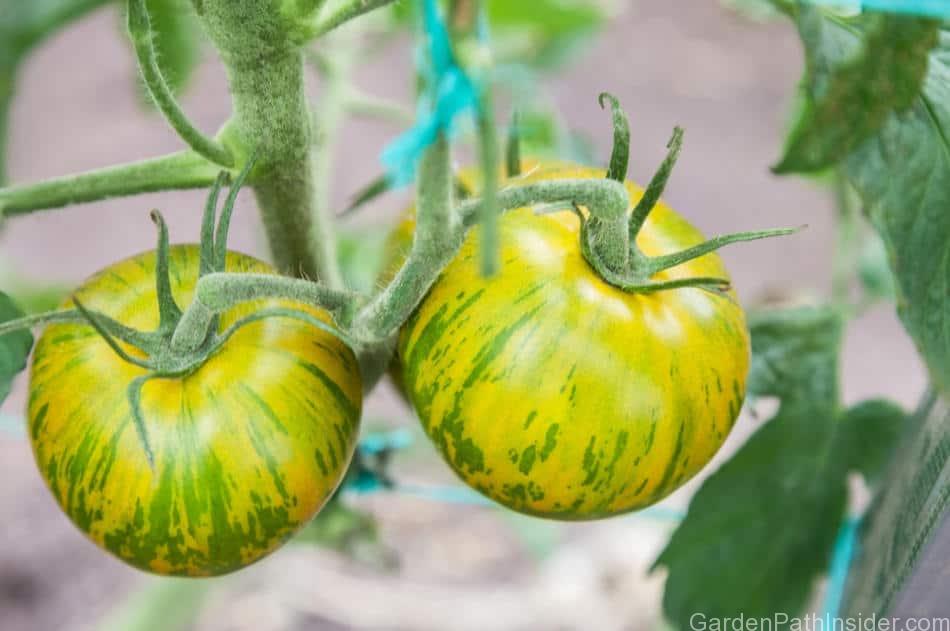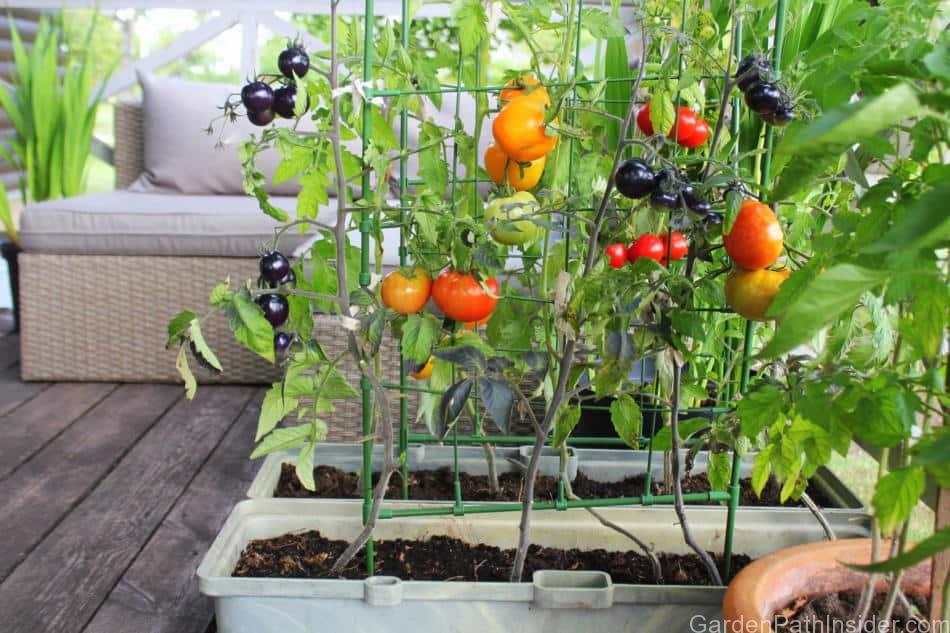
Tomatoes are a great fruit-bearing plant to grow indoors. There are several different varieties of tomato plants from small tabletop tomato plants to full-size tomato bushes. You will be able to find a tomato variety to fit your needs and the size of your cultivation environment.
Tomatoes can be grown indoors year-round from seeds or sprout-lings, using regular potting soil and water. To grow tomatoes indoors year-round you will need to introduce grow lights to your indoor tomato plants from early fall, through winter, and into late spring as the normal daylight hours will not provide enough light for the tomato plants.
Growing tomatoes indoors can provide a delicious harvest year-round and is a great hobby for gardeners of all skill levels. Below are the simple steps to get you growing in no time using garden supplies you can pick up at your local hardware store.
Choosing the Right Variety of Tomato Plants

There are THOUSANDS of varieties of tomatoes currently in cultivation, each having unique, size, textures, and taking different amounts of time to reach maturation.
The different varieties of tomatoes will determine several factors:
- The final size and height the plant will reach when it starts producing flowers and fruit.
- The size of the tomatoes (Cherry tomatoes vs. the 4 lbs Big Zac Heirloom Tomato).
- The care and maintenance needs from light exposer to water requirements.
If you shop at your local plant nursery or hardware store you will be able to find plants that will grow and thrive in your locale climate.
Other options for starting plants include buying seeds at the store or online, and my favorite method of all… growing tomato plants from Tomato slices! More on this method below.
Once you have identified the available space you have for your tomato garden you can more accurately research and select the variety of tomatoes you will grow, then we can move to the next step of germinating and sprouting your tomato seed.
Beginning Tomato Plants from Seeds or Tomato Slices
Here we will review how to begin tomato plants from seeds. If you are buying young plants from the plant nursery or store you can skip to the next section, although you may want to stick around to learn how to turn tomato slices into tomato plants!
How to Germinate Tomato Seeds
Begin with a small pot or container with drainage holes on the bottom. This can be made of clay, plastic, or compostable starter pots.
The soil should be a light starter soil. It is not recommended to start with topsoil, as the topsoil may contain harmful bacteria or be too dense for the roots of the seeds to develop and propagate.
Potting mix from online or the local home store is preferred, and there is soil specifically formulated for potted fruit and vegetable plants.
Fill the pot up with soil leaving about half an inch of space between the top of the soil and the top of the potting container. Thoroughly water the soil until its damp throughout.
Place two to three tomato seeds in each pot, spacing the seeds evenly apart. Plant a few seeds in each pot to increase the chances of sprouting several healthy seedlings.
If all the seeds successfully develop in the same pot, we can separate them later when we transplant into the larger growing containers. Germination will take 5-10 days for sprout-lings to break through the soil.
Propagating Tomatoes from Tomato Slices
- Use a ripe tomato, cut the tomato into slices 1/3 inch thick (8.5 mm)
- Fill a pot with soil three-quarters full. Tomato slices can be propagated in a small shallow pot, though a 1-gallon bucket or pot is best for multiple tomato slices.
- Lay the slices on the soil and cover lightly with additional soil.
- Water thoroughly and keep the soil moist, checking the soil daily.
- Propagation will take 14 to 20 days for the tomato slices to sprout.
- Begin to transfer the sprout lings to separate containers once they reach 2 to 4 inches (5cm to 10cm) tall.
- The section below covers transplanting in more depth.
Transplanting Tomato Seedlings

Once the seedlings have grown 2 to 4 inches (5cm to 10cm), transplant to their own separate larger potting containers.
Large pots or 5-gallon buckets work best for most of the larger varieties of tomatoes. Smaller pots that can fit on your kitchen counter are great for smaller varieties like cherry tomatoes, or Tiny Tim tomatoes.
- Use a container that has draining holes and will let excess water easily drain out.
- The soil can be a potting mix from the store or a 50/50 mix of garden topsoil and organic compost.
- Before filling the pot with soil, make sure to add some gravel or a few small rocks over the drainage holes to prevent the soil from blocking the holes and not allowing water to fully drain from the pot.
- Take the seedling out of the small container and remove any leaves from the bottom third of the seedling.
- Dig a hole deep enough to bury the root ball and the stem we’ve just removed the leaves from. The stem of the tomato plant can develop roots.
Burying the plant deep will allow new roots to grow from the stem, providing better stability and nutrient absorption as the plant matures. If you plant 2 tomato seedlings in one container, make sure it’s large enough to provide 6 to 8 inches (15-20cm) of separation.
Care and Maintenance for Tomato Plants

Water the growing plant daily as needed to maintain a damp soil. Water the roots, not the leaves. Any water that sits on the leaves can cause mold or rot.
Fertilize the tomato plants once they are transplanted and again every two weeks.
Pollination for Your Indoor Tomato Plant
When the tomato plant is grown outdoors the tomato plant flowers can be pollinated by insects or the wind. Tomato flowers can self-pollinate as tomato plant flowers have both the male and female parts needed to reproduce within a single flower.
You can help this pollination along by gently tapping branches with the flowers. The gentle tapping should provide the stimulus for the flower to develop a tomato.
Support the Plant As It Grows

Place a long wooden stake in the soil next to the plant and begin to tie the plant to the wooden stake as the plant grows.
As the tomatoes begin to form the plant will undergo a tremendous amount of stress and need support to keep the plant from tipping over and breaking.
You can also use a tomato trellis and twine to aid the plant as it grows.
Harvesting Tomatoes from Your Indoor Garden
Each variety of tomato will ripen at different times; however, most varieties ripen within 95 days and 125 days.
As the tomatoes ripen you can remove the tomato using a pair of scissors. Cut an individual tomato off the vine, or if all the tomatoes in a pod are ripe you can cut off the full pod on one branch.
Lighting Needs for Growing Tomatoes Indoors Year-Round
During the normal growing season of early spring to late fall you can leave your indoor tomato plant by a window that gets 6-8 hours of sun each day. If you are growing tomatoes indoors in the winter, you will need to use an artificial lighting source to ensure the tomato plants get enough sunshine to grow and develop a healthy harvest.
LED lights (Light-Emitting-Diodes) are a preferred light source for indoor growing as they produce a high-quality light, and the lights are more energy-efficient consuming much less energy than fluorescent, or high-power sodium lights.
Each variety of tomato will have instructions for the optimal growing conditions. From experience, I’ve found 6-8 hours of light each day is perfect for most varieties.
Thank you for visiting and best of luck with your indoor tomato garden!
Cover image: Tomato growing in organic farm_© Elena Vyaseleva/123rf.com
